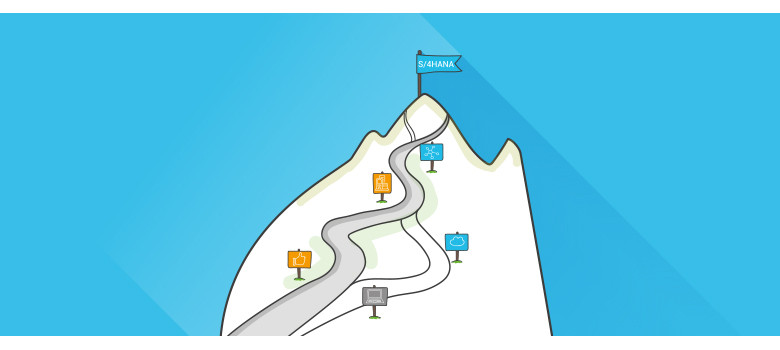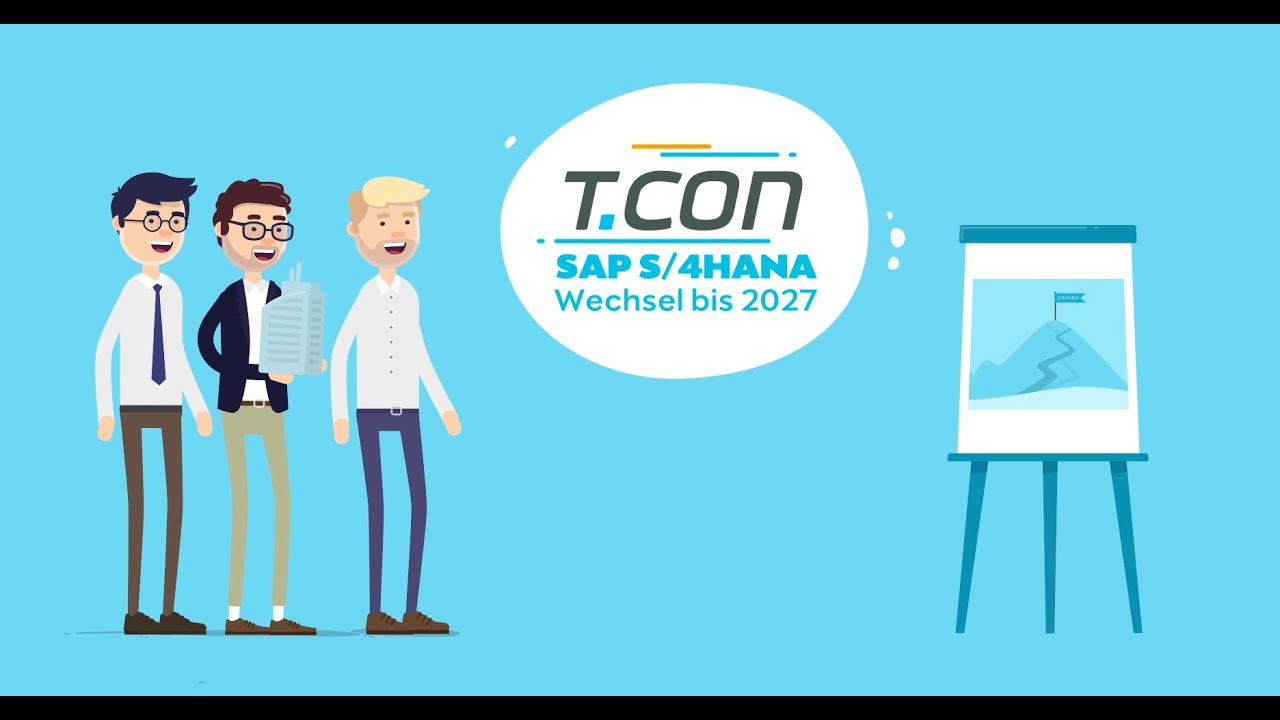Let's get in touch.
Ernesto Flores, Headquarters Plattling
ContactSAP S/4HANA Transition


The end of official support for SAP Business Suite 7 may still seem a long way off, but nonetheless: Now is the time to migrate to SAP S/4HANA! There are many reasons not to delay your S/4HANA project.
Widening the feature gap
As the SAP S/4HANA development continues, the functional and technical gaps between the new system and your existing SAP ERP system will keep growing. This means that the longer you wait, the more complex it will become to upgrade from your ECC system – and that means rising costs and longer project runtimes.
Need for better usability and modern user experience
SAP ERP does not meet the requirements for a modern, mobile-enabled employee experience. You can't fully exploit potential for efficiency improvements. The longer employees have to wait for contemporary Fiori interfaces – still lacking in many parts of the system – the more satisfaction and acceptance will fall. And if you're hiring: new employees also expect to find a modern working environment.
Inadequate decision-making
Making business decisions based on analytical data has gained hugely in importance over the last few years. Your SAP ERP system is one of your most important sources of decision-making data.
However, the established system technology is not designed for modern real-time analyses and real-time decision-making, and therefore not suitable for efficient process control and company management.
Less investment security, lower innovation capacity
Migrating to SAP S/4HANA at the right time protects you from technical debt and ensures investment security. You will be in the right position to implement innovative projects and launch strategic digitalization initiatives, building securely on cutting-edge, future-proof SAP technology.

Companies who follow the greenfield approach take the SAP S/4HANA migration as an opportunity to comprehensively redesign their processes. Process analysis is a major component of the project.
You will install the new SAP S/4HANA system and migrate existing master data and transaction data – of course, all without interrupting ongoing business processes. Since S/4HANA includes new features even in the standard version, some in-house developments that you are currently using to extend your SAP ERP system can then be left out.
The greenfield approach stands for transition in its purest form, leaving behind evolved structures and organically-grown organizational requirements. It is the sensible approach when you want to achieve a system with no modifications and without carrying over cumbersome historical workarounds.
The basis of the brownfield approach is the technical system conversion, in which the existing SAP ERP system is replaced with SAP S/4HANA in a gradual process.
You still carry out an analysis of your existing processes, but in this approach they are not updated until it becomes essential to do so. The majority of the existing processes will remain in use.
A few carefully chosen new processes can also be implemented as part of the system conversion.
Enterprises who follow the brownfield approach benefit from automatic migration of master data and transaction data. This form of transition to SAP S/4HANA is very economical on resources.
This is the approach taken by most of our customers, as it combines the best of both worlds: the technical SAP S/4HANA transition is driven forward, but combined with well-defined process changes.
You can exploit most of the potential of SAP S/4HANA, without having to entirely redefine your processes. Costs and project duration settle around the “middle ground” between the brownfield and greenfield approaches. This procedure also allows you to tailor the scope of the process changes to individual needs and priorities.
The SAP Readiness Check is an important tool when preparing for your SAP S/4HANA migration. We also use a Readiness Check ourselves: during our preparatory workshops, to check the system status against the Simplification List for the corresponding version of the S/4 target system.
We follow this with technical checks of the database version, at operating system level, for the HANA sizing, and detailed custom code checks. This enables us to develop tailored process optimization suggestions for our customers based on their ERP usage: the business scenario recommendations.
This S/4HANA preliminary analysis – extending the Readiness Check with numerous other reviews – means we can give your company a clear agenda for what happens next.
There is no one-size-fits-all answer to the question of how much work and costs are associated with the SAP S/4HANA transition. However, it is clear that transition takes considerably less time, money and resources than a completely fresh install. Before you can start on the detailed project planning, you will need a definition of your objectives and an analysis of the system landscape. Many companies reach their goal in less than a year, sometimes even within six months.

Our customers find that our experience in this area really pays off – we started building expertise in this area when the field was still very young, and have now built up our own SAP S/4HANA Competence Center, for which we also train new team members.
T.CON was a selected partner for the SAP “10Steps2S4” program. Our involvement from this early stage taught us a lot about project procedures – knowledge which paid off right from the start with our first SAP S/4HANA projects. Now, with numerous successful projects under our belts, we have accumulated considerable expertise and been able to refine our approach even more.
For example, we recommend that our customers start with the technical conversion, and then tackle optimization projects at a later, separate stage. This keeps down the complexity of the transition to SAP S/4HANA.
Our lean “Team of six” approach to conversion projects has also proved its worth. The principle is to put together a team with an expert from each of six domains: project management, core, development, finance/controlling, business partner/logistics and “miscellaneous” modules. Other experts, e.g. for interfaces, BI, permissions or forms, can be brought in as needed.
The small core team is able to work with low resource requirements and efficient pathways. The result is top-quality projects in a short timeframe.
We also have competence in the fields of Managed Services, Analytics and HR, and can weave these themes into your project in the form of IT architecture, BI strategy, digitalizing HR systems, etc. Another choice many customers make is to take this opportunity to outsource operation and maintenance of their new SAP S/4HANA system in our S/4-certified data center.
"SAP S/4HANA" is short for SAP Business Suite 4 SAP HANA, and is the next generation SAP application suite. It is a brand-new product, which has been developed based entirely on the powerful SAP HANA in-memory platform and integrated with the modern SAP Fiori user interface. The key feature of S/4HANA is its radical simplification of the data model and user experience, thereby making it easier for companies to simplify their business processes.
The advantages of SAP S/4HANA are evident: SAP S/4HANA, as the digital backbone for all value creation processes, establishes the conditions needed for your enterprise to exploit the opportunities of digitalization. You can react more quickly and flexibly to market requirements and use real-time data analyses as a quantitative basis for decision-making.
When you transition to SAP S/4HANA, various components are integrated directly into the software kernel, eliminating various interfaces and redundant data, which reduces infrastructure costs and cuts down on operating resources. Employees and management can visualize reliable KPIs in real time, and you'll also see benefits for reporting process efficiency. Decisions based on hard numbers become part of the business workflow.
Central logistics components such as Extended Warehouse Management and Transportation Management are also integrated. This brings additional benefits as material movements for production are automatically recorded all the way through to financial accounting. Operations can be tracked in real time and their effects on the operating result are immediately apparent.
We can see the benefits by looking at successful transition projects to date: SAP S/4HANA improves query performance, with lower response times. Its intuitive user interface encourages users to launch their own queries; it also proactively supplies the figures that they need for their work.
There are various operating models available for S/4HANA, and SAP customers can select the model best suited to them: Local/on-premises (with the usual options for full system customization and extension), Managed Cloud (individual system hosted in the SAP datacenter) and Public Cloud (standardized multi-tenant cloud solution for simplified business processes from selected industries).
Simple Finance was the first step in SAP S/4HANA's customer roadmap. It demonstrated the significant advantages of a simplified data model (e.g. no indexes, no aggregates), and has been functionally incorporated into S/4HANA.
SAP has committed to support the Business Suite until 2027, which can be extended to 2030 for an additional cost. However, all support will come to an end at that point. The end of SAP ERP support has legal and financial consequences. Obviously, your processes will not all grind to a halt just because SAP is no longer actively supporting the old ERP technology. SAP ERP as we know it still exists and will keep working. However, without regular support and updates from SAP, the legal and financial risks will mount up.
For example, customers will no longer be able to turn to official SAP support to resolve technical issues. There will also no longer be official patches, for example if security holes are found in the systems. Systems that are no longer maintained can become security risks – and therefore liability risks. This means that when support comes to an end, businesses still using the old systems will need a reliable partner or dedicated department who can maintain their ERP solutions. Depending on the scope of the support required, this could permanently tie up a large part of the IT budget.
S/4HANA is not a replacement for SAP's existing Cloud portfolio, it is integrated into it and extends it. SAP customers can set their own pace for their path into the Cloud. There are simple, standardized options for integrating the ERP system with cloud solutions as required (for example, SuccessFactors, Ariba, and Concur).
Runtime licenses for third-party databases are not affected by this new maintenance strategy of Business Suite 7.
However: S/4HANA only runs on the SAP HANA platform. SAP S/4HANA is the next logical step for existing SAP customers and largest step forward for several years — and it is fully compatible with SAP ERP 6.0.
If an existing SAP ERP customer wants to move to SAP S/4HANA, this can essentially be done in a single step, with a single downtime, regardless of the Enhancement Package installed. The only condition is that the system must already be in Unicode. However, it is also possible to switch to S/4HANA via a series of steps.
There is no one-size-fits-all answer to the question of how much work and costs are associated with the SAP S/4HANA transition. However, it is clear that transition takes considerably less time, money and resources than a completely fresh install. Before you can start on the detailed project planning, you will need a definition of your objectives and an analysis of the system landscape. For example, this will involve a review of the business functions, add-ons and custom code in use in your enterprise. You also need to decide in advance which processes will be standardized using the SAP S/4HANA technology and which processes you will continue to implement with custom code.
An SAP S/4HANA pre-study is the best preparation for an SAP S/4HANA transition project. The requirements for an SAP S/4HANA transition, which define the project scope and runtime, are different for every enterprise. We sit down together to analyze the situation in your enterprise, identify the dependencies in your ERP landscape and define the optimum implementation pathway. We will also be happy to analyze the technical prerequisites and carry out a custom code analysis. The deliverables you receive include an investment overview, which you can use as a basis for clear-cut budget planning.